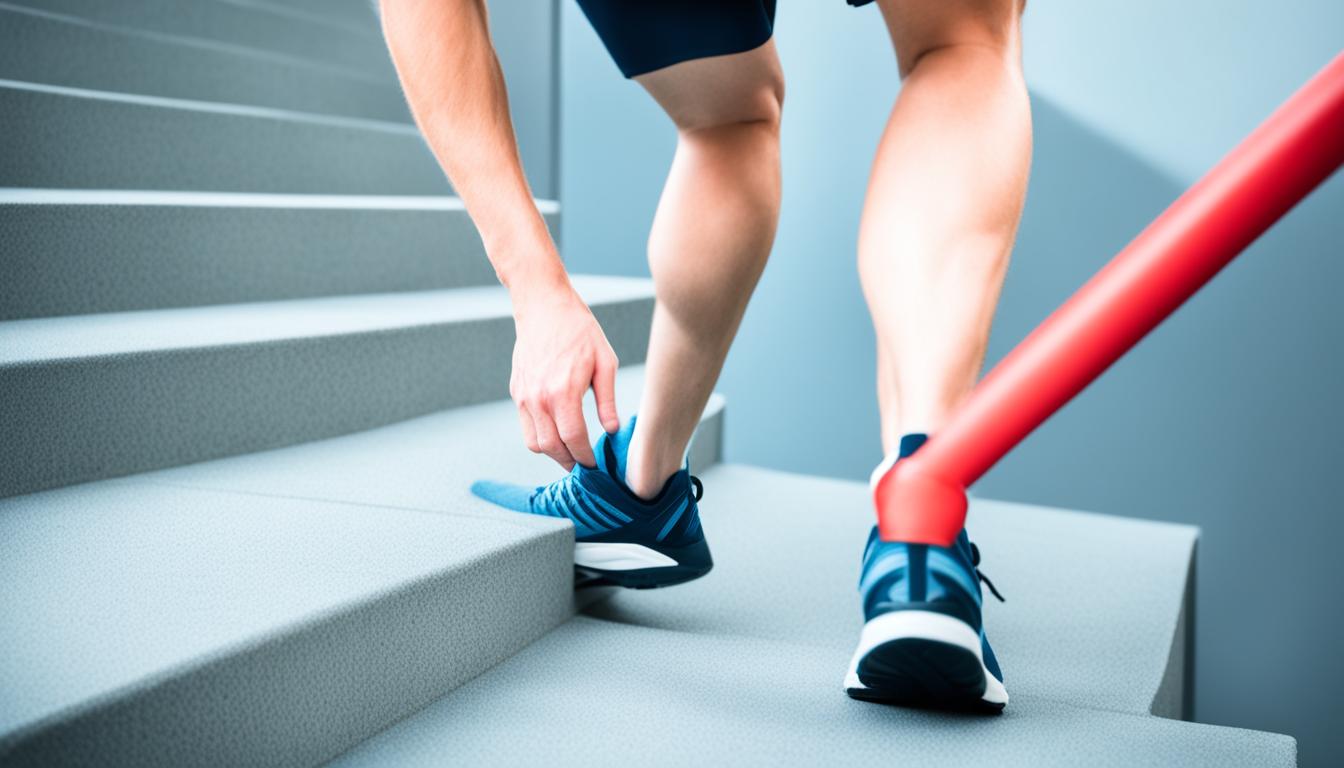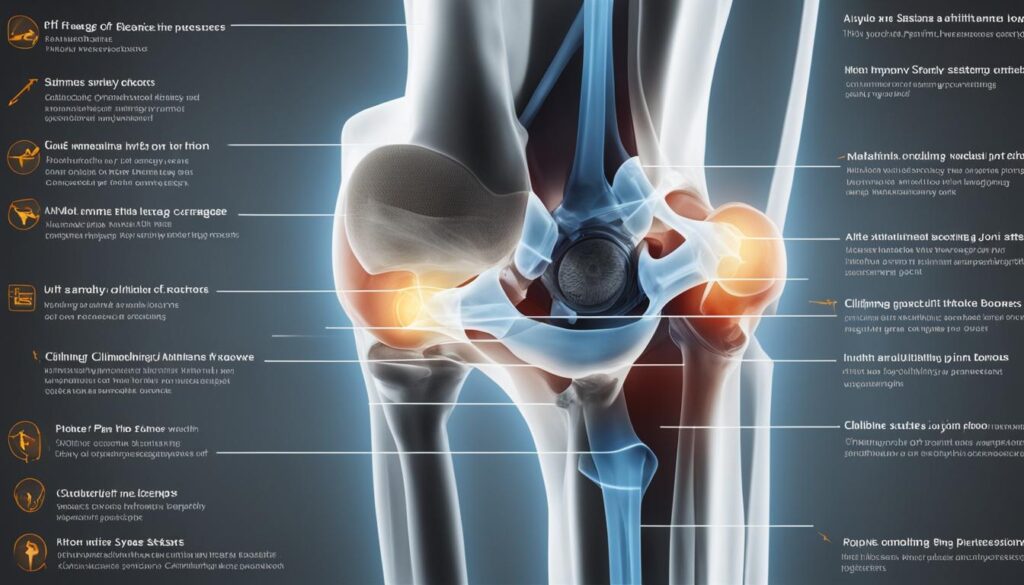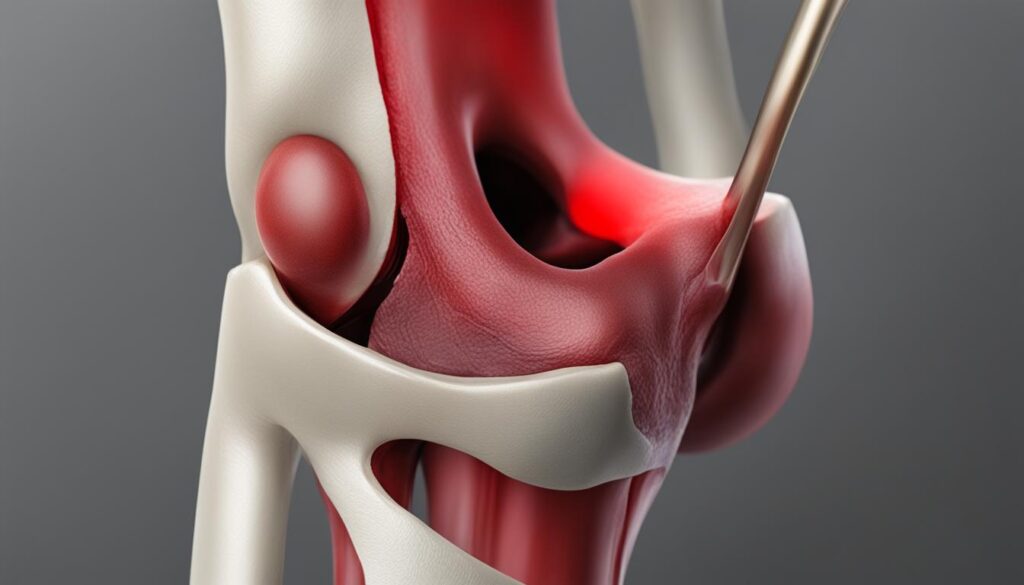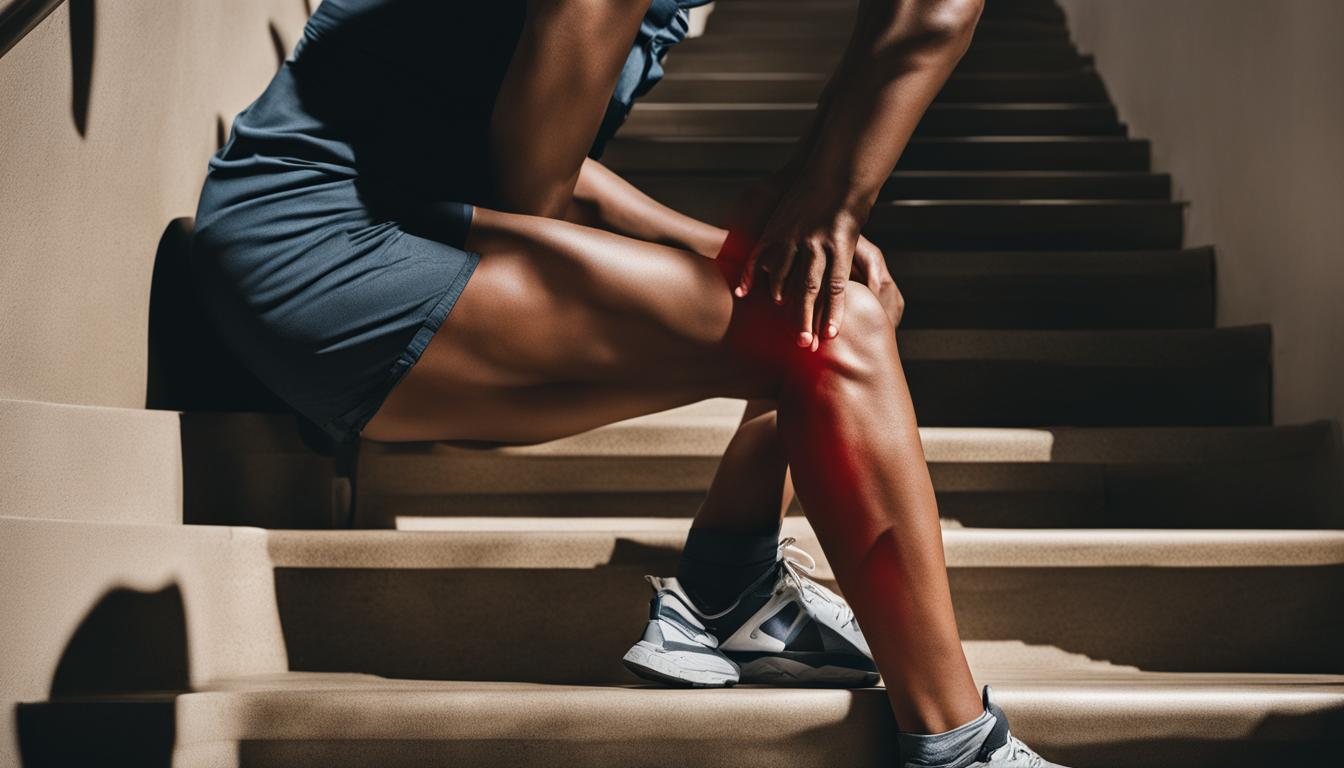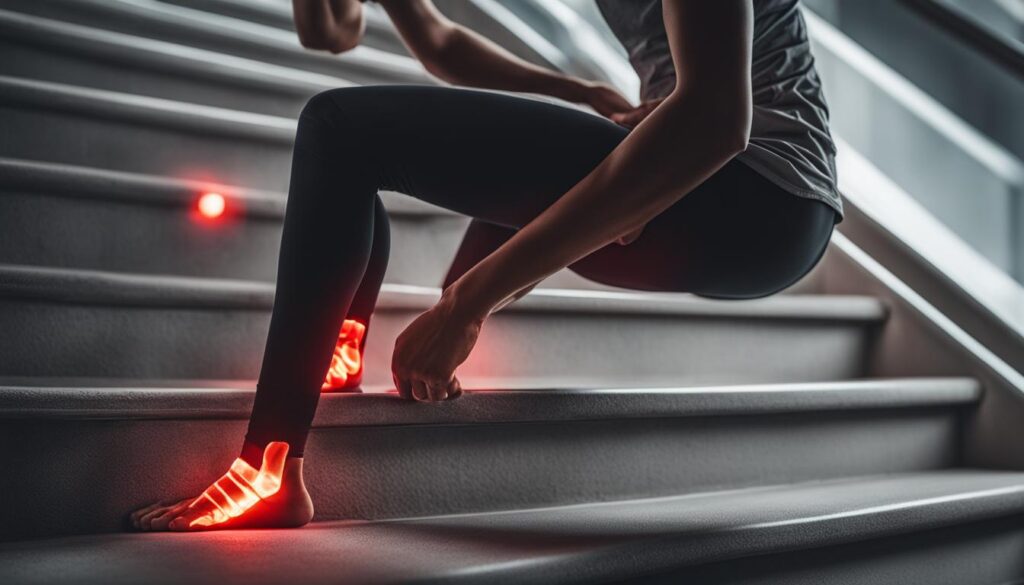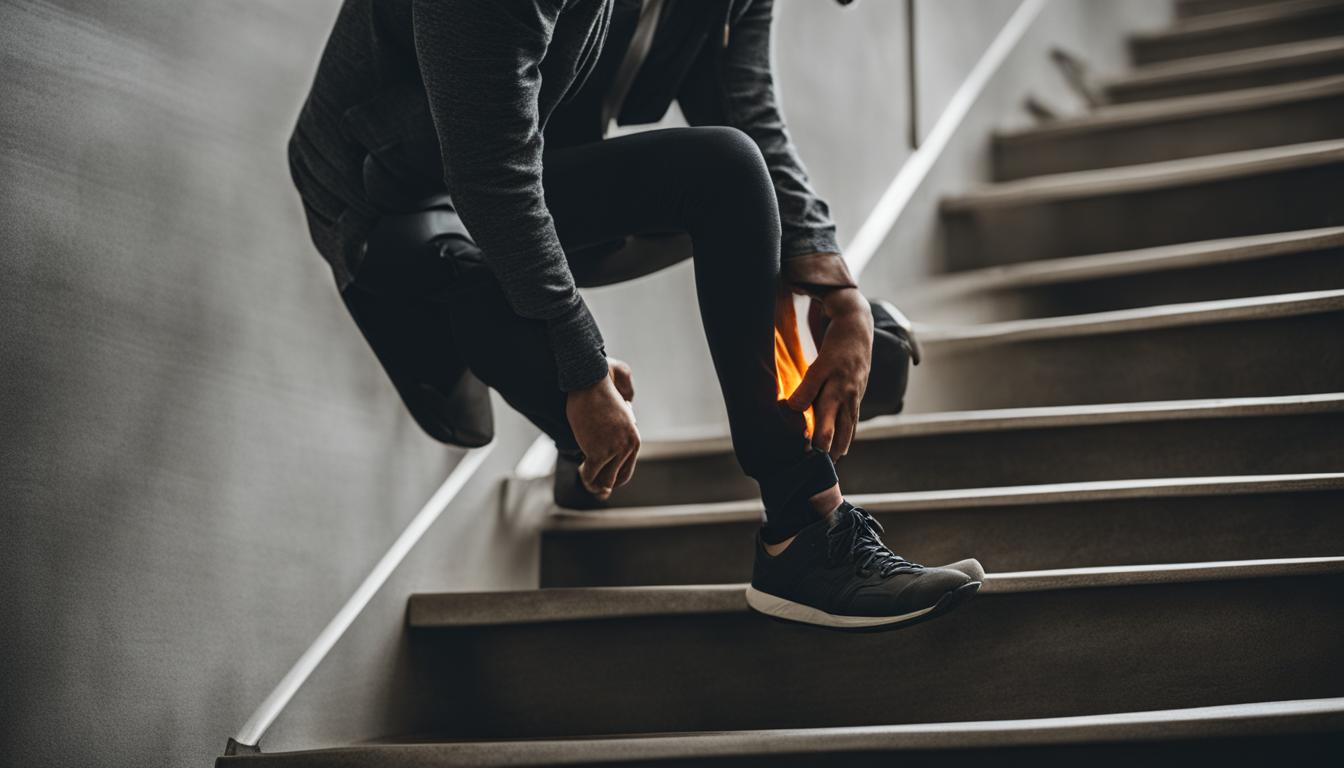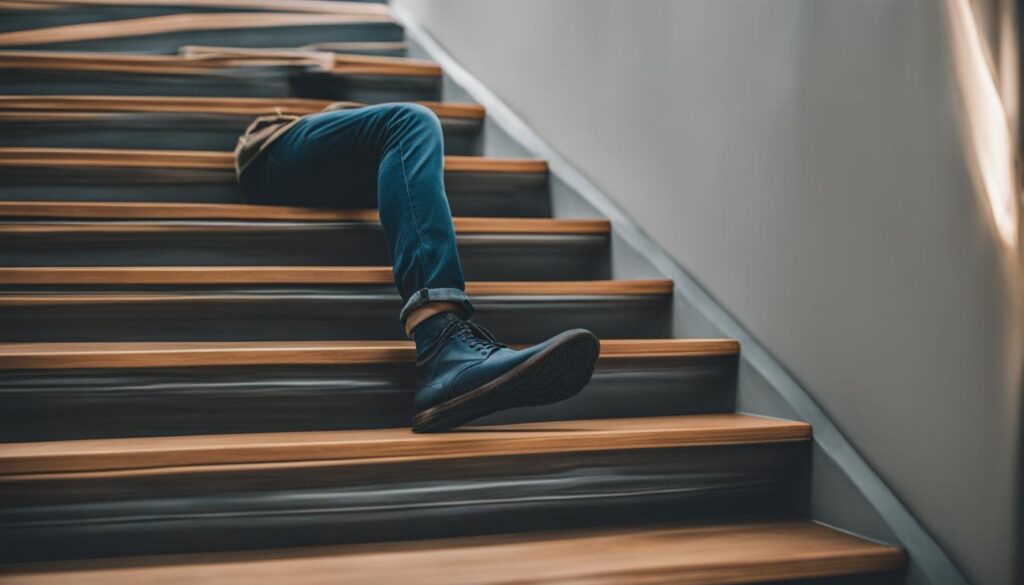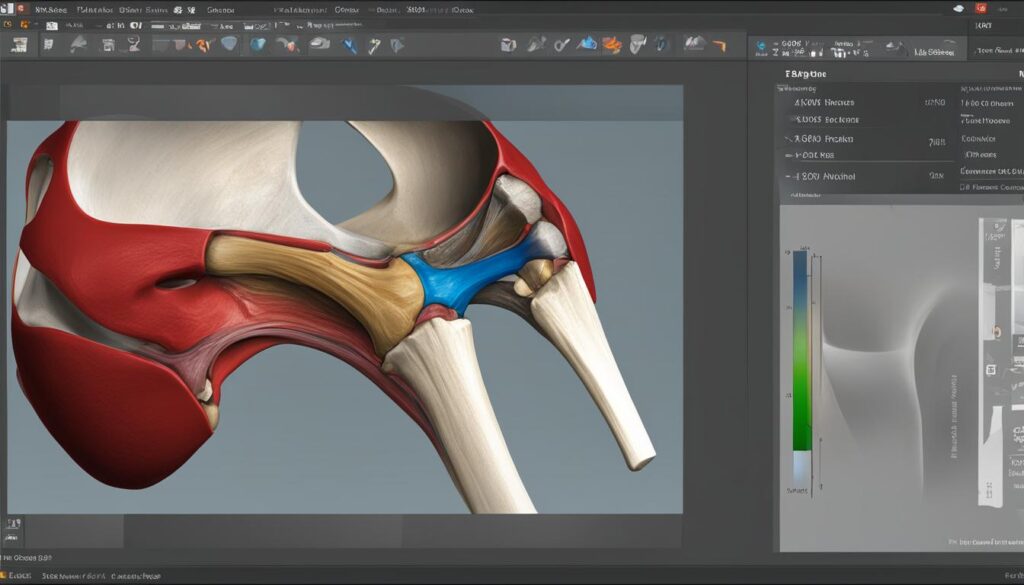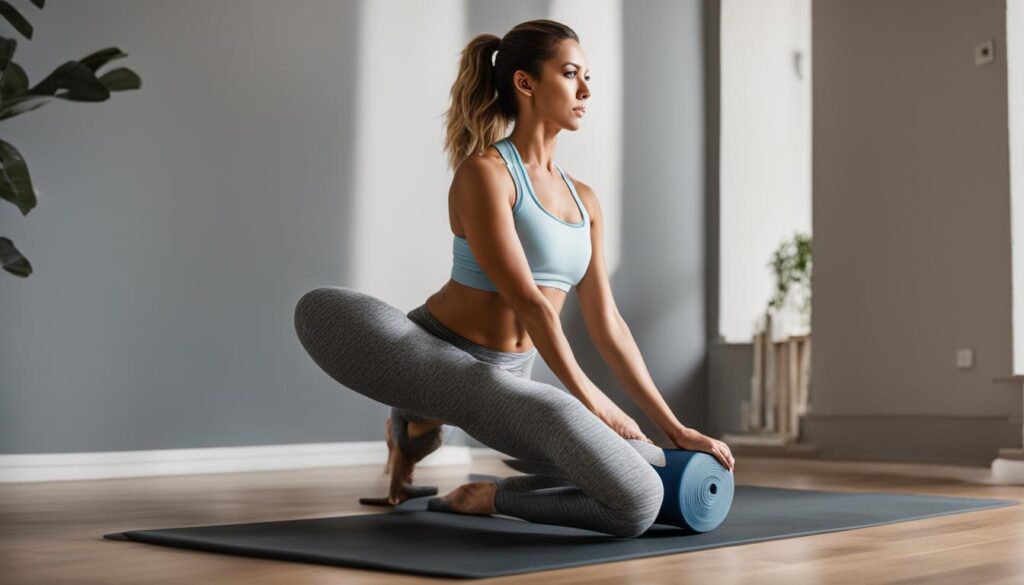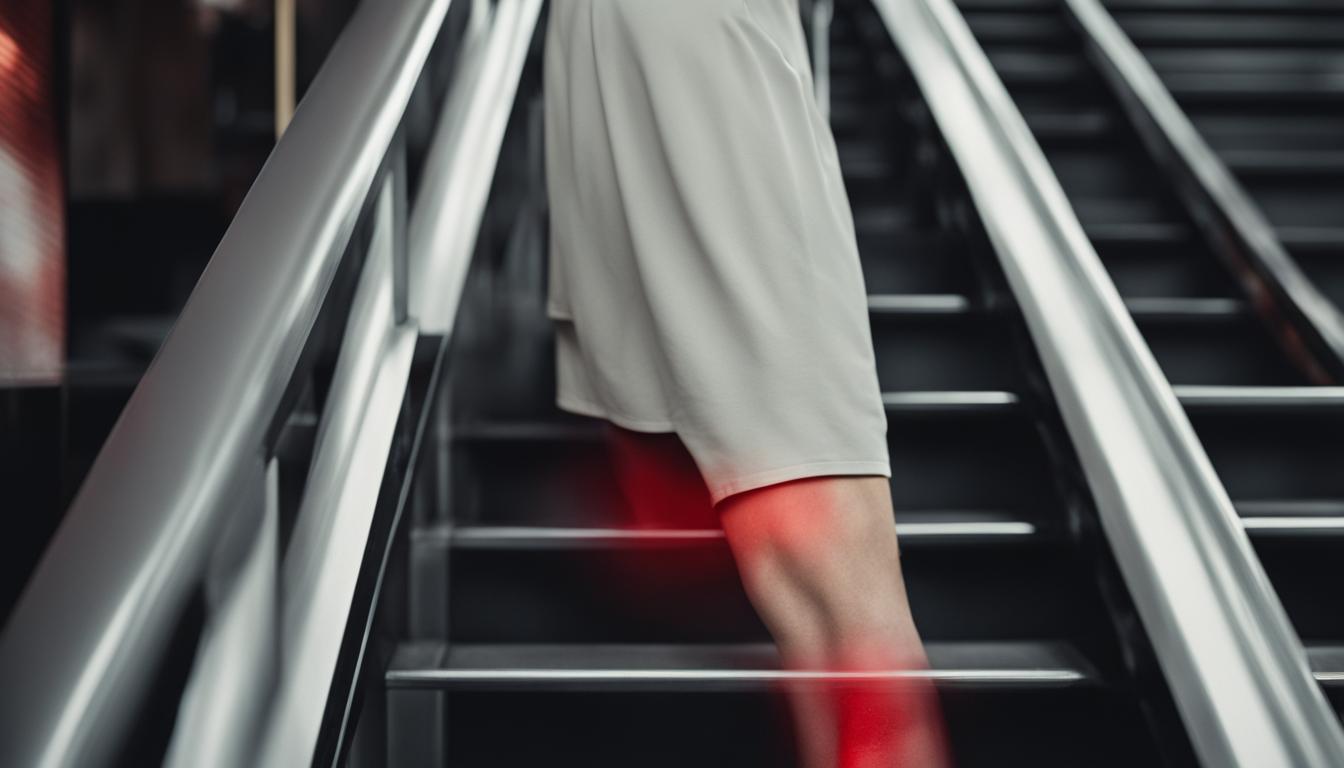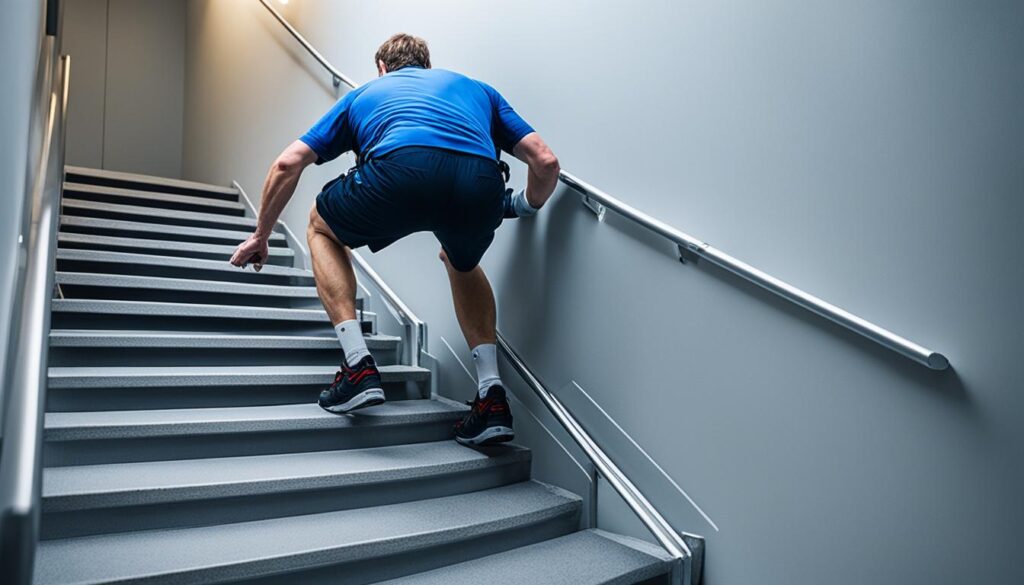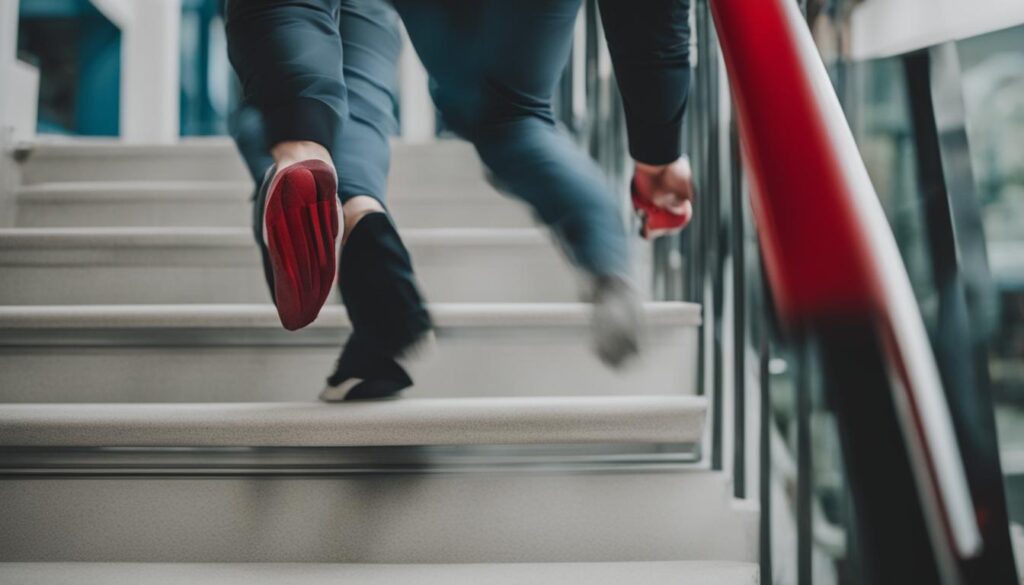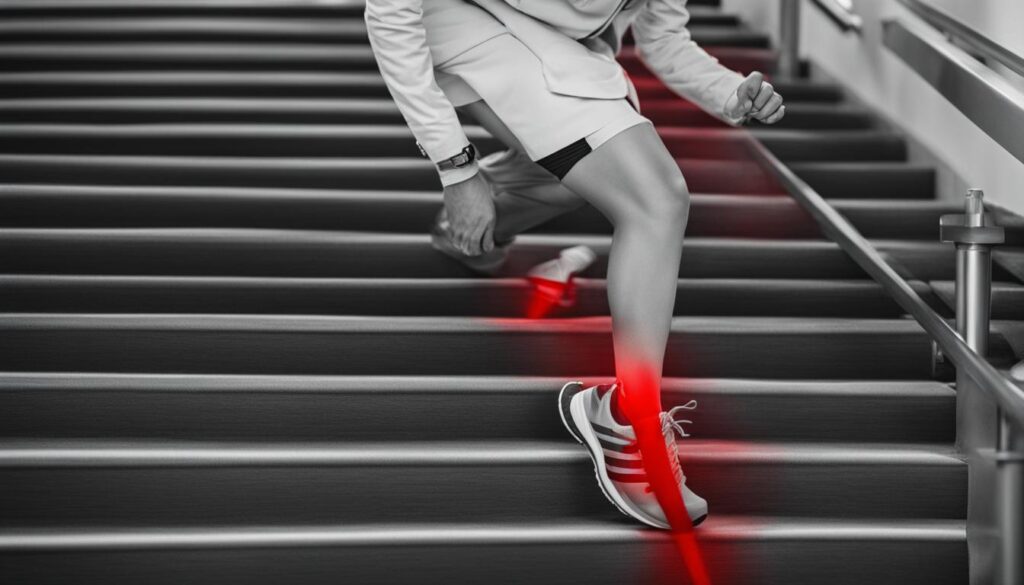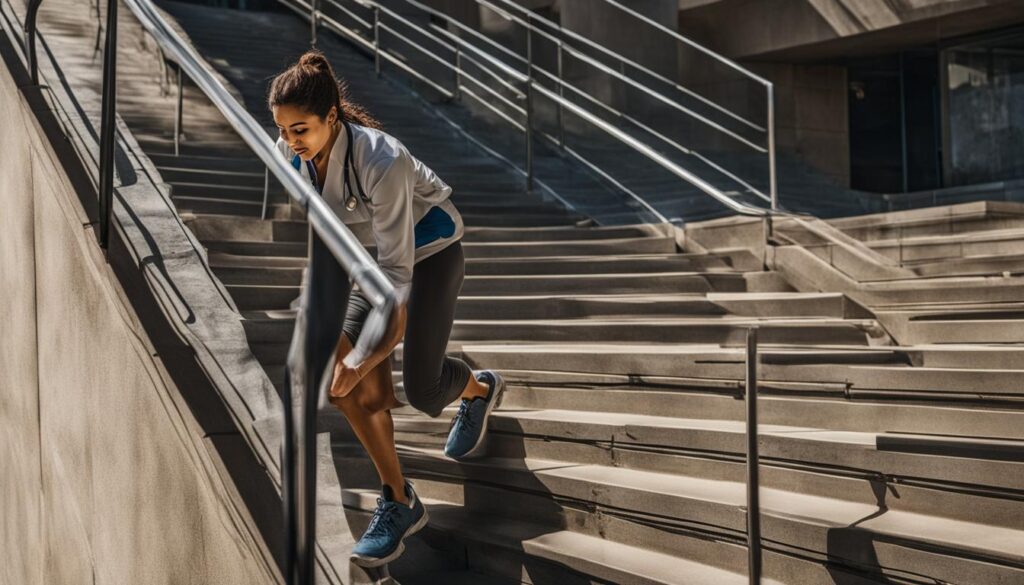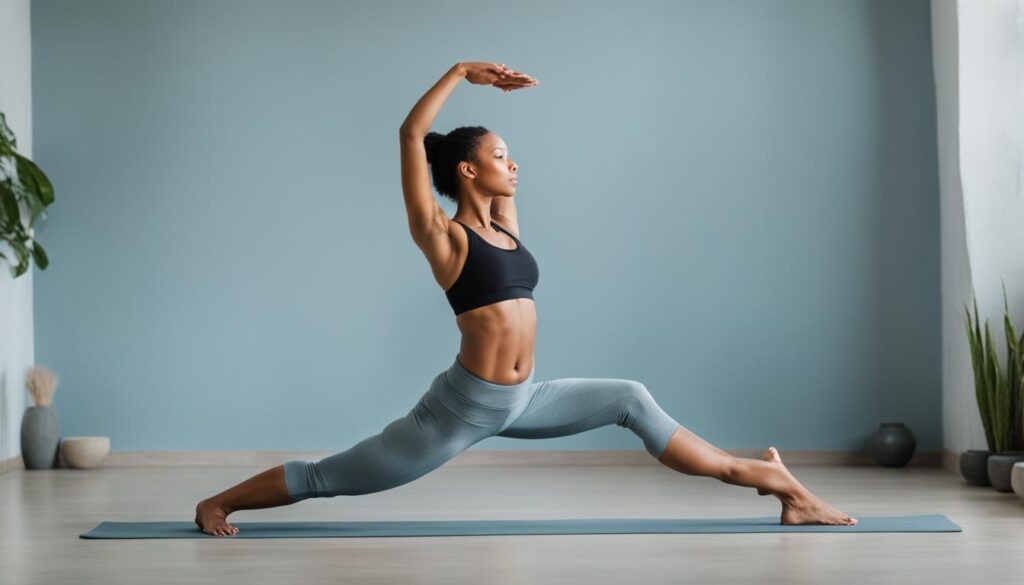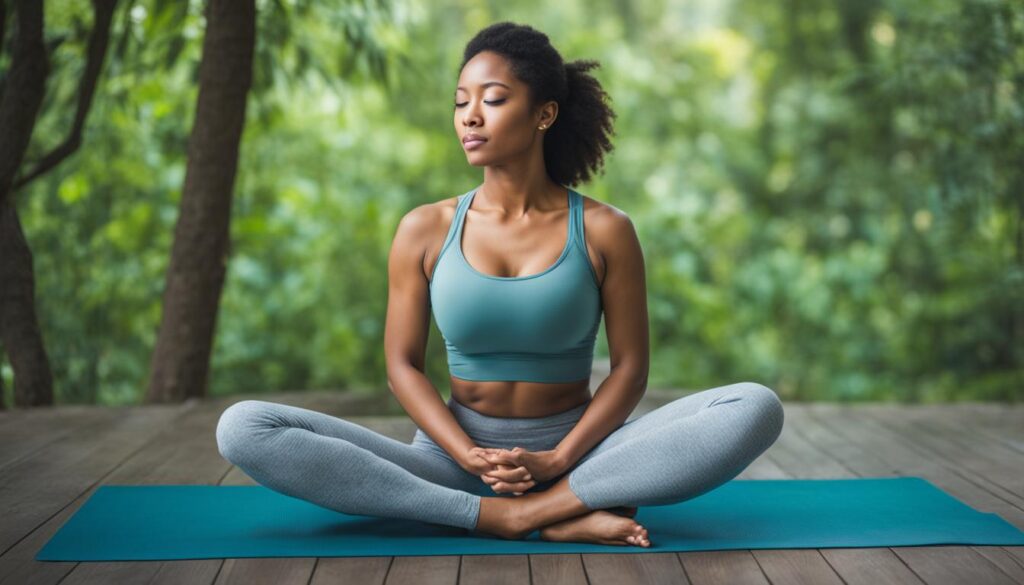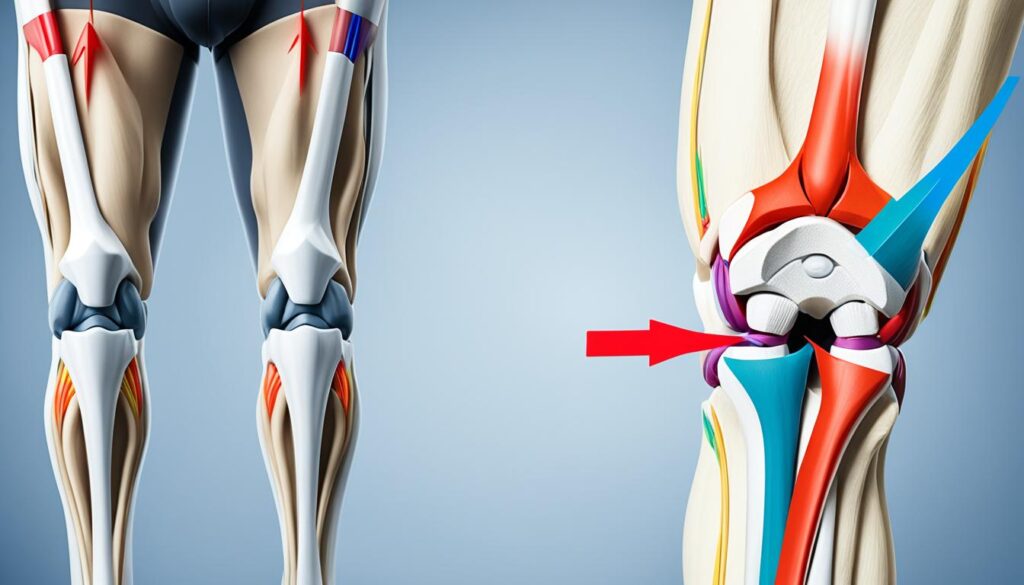Walking up stairs can be a painful experience if you are suffering from knee pain. In order to understand what causes this discomfort, it is important to know the factors that contribute to knee pain on stairs. According to sources such as Heather Broach, PT, DPT, there are various possible causes of knee pain when climbing stairs. These include conditions such as patellofemoral pain syndrome, meniscus tear, chondromalacia patella, IT band syndrome, muscle imbalance, and more. Understanding the underlying causes of knee pain can help in finding effective methods to alleviate the discomfort.
Key Takeaways:
- The causes of knee pain when climbing stairs can range from patellofemoral pain syndrome to muscle imbalances.
- Understanding the anatomy of the knee joint can help in comprehending the factors that contribute to knee pain.
- Treatment options for knee pain on stairs include targeted exercises, body awareness techniques, and modifying walking techniques.
- Therapeutic exercises focusing on strengthening the knee structures can help relieve knee pain and improve knee function.
- If knee pain persists or worsens, it is advisable to seek professional help from a healthcare provider for appropriate diagnosis and treatment.
The Anatomy of the Knee Joint
To comprehend the causes of knee pain on stairs, it is essential to have knowledge about the anatomy of the knee joint. The knee joint consists of various components that contribute to its complex structure and function.
Bones of the Knee
The knee joint is formed by three bones: the femur (thighbone), the tibia (shinbone), and the patella (kneecap). The femur and tibia meet to form the main hinge of the knee joint, while the patella sits in front of the femur, protecting the joint.
Ligaments of the Knee
The knee joint is supported and stabilized by ligaments. The collateral ligaments, located on either side of the knee, prevent the joint from bending sideways. The cruciate ligaments, found inside the knee joint, control forward and backward movement.
Tendons in the Knee
Tendons are strong, fibrous tissues that connect muscles to bones. In the knee, the quadriceps tendon connects the quadriceps muscle to the patella, while the patellar tendon connects the patella to the tibia.
Cartilage in the Knee
Cartilage is a smooth, slippery tissue that covers the ends of bones, allowing them to glide smoothly during movement. The knee joint has two types of cartilage: articular cartilage, which lines the ends of the femur, tibia, and patella, and meniscus cartilage, which acts as a shock absorber between the femur and tibia.
Bursae in the Knee
Bursae are small, fluid-filled sacs that reduce friction between tissues in the knee joint. They serve as cushions and protect the joint from pressure. The knee joint has several bursae, including the prepatellar bursa, infrapatellar bursa, and pes anserine bursa.
Muscles of the Knee
A network of muscles surrounds the knee joint, providing stability and movement. These muscles include the quadriceps muscles, which extend the knee, and the hamstring muscles, which flex the knee.
Nerves in the Knee
Nerves supply the knee joint with sensation and control muscle movement. The sciatic nerve and its branches, such as the tibial nerve and common peroneal nerve, play a role in knee function.
Understanding the intricate structures of the knee joint, including the bones, ligaments, tendons, cartilage, bursae, muscles, and nerves, is crucial in comprehending the factors that contribute to knee pain on stairs. By understanding the anatomy, we can gain insight into how these structures can be affected and lead to discomfort.
Common Causes of Knee Pain on Stairs
When it comes to experiencing knee pain while climbing stairs, several common causes can be responsible for the discomfort. Understanding these causes can help you identify the underlying issue and seek appropriate treatment. The most common factors contributing to knee pain on stairs include:
- Patellofemoral Pain Syndrome: This condition causes pain in the front of the knee and is often a result of overuse or sudden increase in physical activity. It can lead to discomfort when climbing stairs.
- Meniscus Tear: Twisting or pivoting movements can cause a tear in the meniscus, leading to knee pain on stairs.
- Chondromalacia Patella: This condition occurs when the cartilage on the back of the kneecap deteriorates. When the kneecap is flexed, it can cause a dull ache and discomfort while climbing stairs.
- IT Band Syndrome: Irritation of the IT band can cause pain on the outside of the knee, particularly when descending stairs.
- Muscle Imbalances: Imbalances, such as being quad dominant, can contribute to knee pain on stairs. Weak or imbalanced muscles can place additional stress on the knee joint.
By understanding these common causes, you can collaborate with healthcare professionals and devise an appropriate treatment plan to alleviate knee pain and improve your overall mobility.
Treatment for Knee Pain on Stairs
Now that we have explored the common causes of knee pain on stairs, it is essential to focus on effective treatment strategies. By targeting the underlying cause, you can find relief and regain your mobility. Treatment options may include:
- Physical therapy exercises to strengthen the affected knee and surrounding muscles.
- Modifying your movements and adopting proper body mechanics to reduce strain on the knee joint.
- Using supportive devices such as knee braces or orthotics to provide stability and reduce pain.
- Applying ice or heat therapy to reduce inflammation and soothe discomfort.
- Seeking professional guidance from healthcare providers to develop a personalized treatment plan.
Remember, each individual’s situation is unique, and it is crucial to consult with a healthcare professional to determine the most appropriate course of action for your knee pain on stairs.
Treating Knee Pain on Stairs
When it comes to knee pain on stairs, effective treatment options can provide much-needed relief. Targeted exercises that focus on strengthening the knee structures can play a crucial role in managing and alleviating knee pain. By incorporating these exercises into your routine, you can improve the stability and function of your knees, reducing discomfort while climbing stairs.
Targeted Exercises:
1. Hip flexor stretches: Stretching the hip flexors can help release tension and improve mobility in the knees. Perform this exercise by standing with one foot forward, keeping both feet pointing forward. Gently lunge forward, feeling a stretch in the front of your hip. Hold for 20-30 seconds and repeat on both sides.
2. Single-leg lifts: Strengthening the muscles surrounding the knee is key to providing support and stability. Try performing single-leg lifts by standing next to a chair or using a resistance band. Lift one leg out to the side, keeping it straight, and hold for a few seconds. Repeat on the other side.
3. Hamstring stretches: Tight hamstrings can contribute to knee pain. Stretching these muscles can help release tension and improve flexibility. Sit on the edge of a chair with one leg straightened out in front of you and the heel on the ground. Lean forward slightly, feeling a gentle stretch in the back of your thigh. Hold for 20-30 seconds and repeat on both sides.
Along with targeted exercises, developing body awareness is crucial in managing knee pain on stairs. Becoming more mindful of your movement and posture can help you identify any muscle imbalances and correct them. Focus on maintaining proper alignment and engaging the correct muscles during activities that involve stairs.
Modifying Walking Technique:
Another effective approach to treating knee pain on stairs is to modify your walking technique. For example, consciously squeezing your glutes while walking can help improve biomechanics and reduce stress on the knees. Similarly, shifting your weight to your heels as you climb stairs can help distribute the load more evenly and alleviate pain.
Remember, it is essential to understand that the treatment approach may vary depending on the underlying cause of knee pain. Consulting with a healthcare professional, such as a physical therapist or orthopedic specialist, can provide personalized guidance and support in managing knee pain effectively.
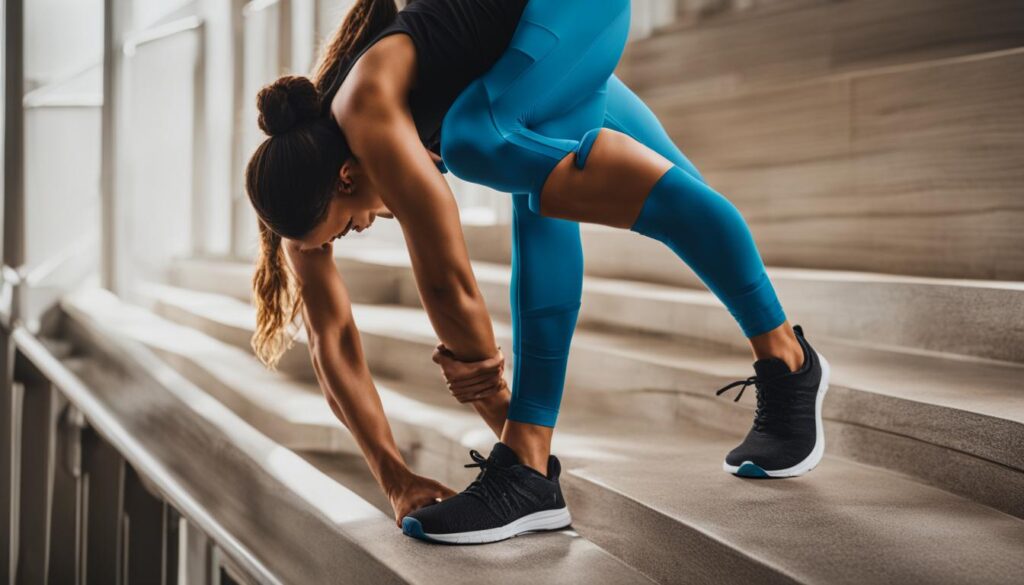
By incorporating targeted exercises, body awareness, and modifying your walking technique, you can effectively treat knee pain on stairs and improve your quality of life. Take the necessary steps to care for your knees and enjoy pain-free mobility while conquering any flight of stairs.
Therapeutic Exercises for Knee Pain Relief
At Hinge Health, our team of physical therapists recommends a series of therapeutic exercises to help relieve knee pain and strengthen the surrounding muscles. These exercises are designed to target the specific areas that contribute to knee pain, providing both relief and long-term benefits. It is important to note that these exercises are intended for educational purposes only and should be performed under the guidance of a healthcare provider.
Strengthening Exercises for Knee Pain
One of the key aspects of managing knee pain is to strengthen the muscles around the knee joint. This not only helps support the joint, but also improves overall stability and reduces the strain on the knee. Here are some effective strengthening exercises:
- Single-leg squats: Stand on one leg and lower your body as if sitting back into a chair, then return to the starting position. Repeat on the other leg.
- Quad sets: Sit on the floor with your legs straight out in front of you. Tighten the muscles on the front of your thigh and hold for a few seconds, then release. Repeat.
- Hamstring curls: Lie on your stomach with a resistance band looped around your ankles. Bend your knees and bring your heels towards your buttocks, then slowly lower them back down. Repeat.
Hip and Lower Back Stretches
In addition to strengthening exercises, stretching is also important for relieving knee pain. Tightness in the hips and lower back can contribute to knee pain, so incorporating these stretches into your routine can be beneficial:
- Hip flexor stretch: Kneel on one knee with the other foot flat on the floor in front of you. Lean forward, keeping your back straight, until you feel a stretch in the front of your hip. Hold for 30 seconds, then switch sides.
- Figure 4 stretch: Lie on your back with your knees bent and feet flat on the floor. Cross one ankle over the opposite knee, then reach through and grab the back of your thigh and gently pull towards your chest. Hold for 30 seconds, then switch sides.
- Child’s pose: Start on your hands and knees, then sit back onto your heels and reach your arms forward, resting your forehead on the floor. Hold for 30 seconds.
By incorporating these targeted exercises and stretches into your routine, you can help alleviate knee pain and improve overall knee function. Remember to always consult with a healthcare provider before starting any new exercise program.
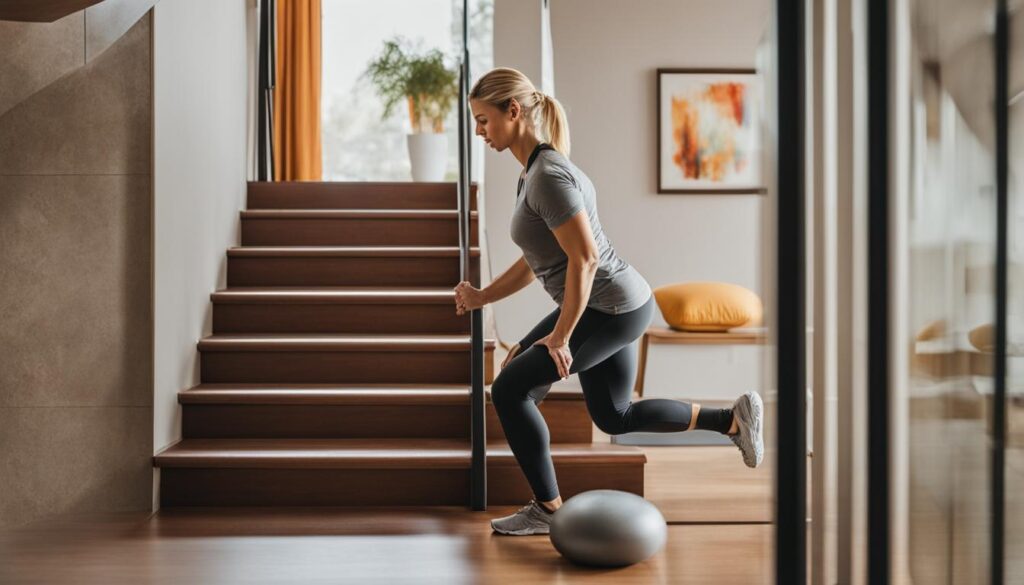
When to Seek Professional Help for Knee Pain on Stairs
If you are experiencing persistent or worsening knee pain when climbing stairs, it is important to consult a healthcare professional for proper evaluation and treatment. While home remedies and exercises can provide some relief, certain cases of knee pain require the expertise of a doctor, physical therapist, or orthopedic specialist to identify the underlying cause and develop an appropriate treatment plan.
Ignoring or neglecting knee pain can lead to further complications and hinder your ability to perform daily activities. Seeking professional help is crucial in order to address the issue promptly and effectively.
When should you consider consulting a healthcare provider for knee pain on stairs? Here are some indications:
- If the knee pain persists for more than a few days despite rest and self-care measures.
- If the pain intensifies during physical activities such as climbing stairs or walking up inclines.
- If you have difficulty bearing weight on the affected knee.
- If there is swelling, redness, or increased warmth around the knee joint.
- If the knee feels unstable or gives way during movements.
- If the pain is accompanied by clicking, locking, or catching sensations in the knee joint.
- If you have a history of knee injuries or previous knee surgeries.
Consulting a healthcare professional will allow for a comprehensive assessment, including a physical examination and possibly imaging tests such as X-rays or an MRI. Based on the findings, the healthcare provider can determine the cause of the knee pain and recommend appropriate treatment options.
“Seeking professional help for knee pain on stairs is crucial for accurate diagnosis and effective treatment.”
Remember, each case of knee pain is unique, and the treatment approach may vary depending on the underlying cause. Whether it’s a strain, ligament injury, meniscus tear, or underlying medical condition, a healthcare provider will be able to guide you towards the most suitable treatment options to alleviate your knee pain and promote optimal recovery.
| Signs to Seek Professional Help for Knee Pain |
|---|
| Persistent knee pain lasting more than a few days |
| Increased pain during physical activities like climbing stairs |
| Difficulty bearing weight on the affected knee |
| Swelling, redness, or increased warmth around the knee joint |
| Feeling of knee instability or giving way |
| Clicking, locking, or catching sensations in the knee joint |
| History of knee injuries or surgeries |
Conclusion
Knee pain when climbing stairs can be a debilitating issue that affects many individuals. By understanding the causes of knee pain, we can take proactive measures to prevent and manage this discomfort. Conditions such as patellofemoral pain syndrome, meniscus tear, chondromalacia patella, IT band syndrome, and muscle imbalances are common culprits of knee pain on stairs.
To address knee pain, targeted exercises are often recommended. These exercises aim to strengthen the knee structures and surrounding muscles, providing support and stability. Additionally, practicing body awareness exercises can help correct muscle imbalances and improve overall movement patterns.
If knee pain persists or worsens despite home remedies and exercises, it is crucial to seek professional help. Consulting a healthcare provider, such as a physical therapist or orthopedic specialist, can provide a comprehensive evaluation and individualized treatment plan. Seeking timely intervention is essential for proper healing and to prevent further complications.
By implementing preventive measures and actively managing knee pain, individuals can continue to navigate stairs without discomfort. Maintaining knee health through exercises, proper rest, and listening to our bodies can go a long way in preventing knee pain and promoting overall well-being. With the right approach, we can overcome knee pain on stairs and enjoy a pain-free, active lifestyle.
FAQ
What are the possible causes of knee pain when climbing stairs?
The possible causes of knee pain when climbing stairs include conditions such as patellofemoral pain syndrome, meniscus tear, chondromalacia patella, IT band syndrome, and muscle imbalance.
How does patellofemoral pain syndrome contribute to knee pain on stairs?
Patellofemoral pain syndrome, often caused by overuse or sudden increase in physical activity, can result in pain in the front of the knee, making climbing stairs painful.
What is a meniscus tear and how does it cause knee pain on stairs?
A meniscus tear can occur from twisting or pivoting movements, leading to knee pain on stairs.
What is chondromalacia patella and how does it cause knee pain on stairs?
Chondromalacia patella is a condition where the cartilage on the back of the kneecap deteriorates, causing a dull ache in the kneecap when flexed, including when climbing stairs.
What is IT band syndrome and how does it contribute to knee pain on stairs?
IT band syndrome is characterized by irritation of the IT band and can cause pain on the outside of the knee, especially when going down stairs.
How do muscle imbalances contribute to knee pain on stairs?
Muscle imbalances, such as being quad dominant, can put extra strain on the knee and contribute to knee pain when climbing stairs.
What are some treatment options for knee pain when climbing stairs?
Treatment options for knee pain when climbing stairs include targeted exercises to strengthen the knee structures, body awareness exercises, and modifying walking techniques.
What are some therapeutic exercises recommended for knee pain relief?
Therapeutic exercises for knee pain relief may include hip flexor stretches, single-leg lifts, hamstring stretches, and more.
When should I seek professional help for knee pain on stairs?
If your knee pain when climbing stairs persists or worsens despite home remedies and exercises, it is advisable to consult a healthcare provider, such as a physical therapist or orthopedic specialist.
